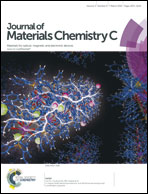Difunctional chemosensor for Cu(ii) and Zn(ii) based on Schiff base modified anthryl derivative with aggregation-induced emission enhancement and piezochromic characteristics†
Abstract
Three new anthryl Schiff base derivatives containing a similar molecular structure were synthesized through a simple method and their fluorescent properties were investigated in detail. Among these, compound 1 displayed an aggregation-induced emission (AIE) feature, 2 exhibited an aggregation-induced emission enhancement (AIEE) property, while 3 showed aggregation-caused quenching (ACQ) behavior. Single-crystal structure and theoretical calculation analysis show that the larger conjugation and the existence of multiple intra- and intermolecular interactions restricts the intramolecular vibration and rotation, which benefit the emission in the condensed state, while the tight dimer structure and intramolecular torsional motion induce fluorescence quenching. Moreover, compound 2 can be utilized as fluorescence on–off type sensor for Cu2+ in methanol–H2O (4/1, v/v, pH 7.2) HEPES buffer solution, as well as fluorescence off–on type sensor for Zn2+ in pure methanol solution. The 2 : 1 ligand-to-metal coordination pattern of the 2-Cu2+ and 2-Zn2+ were calculated through a Job's plot, and were further confirmed by X-ray crystal structures of complexes 2-CuBr2 and 2-ZnCl2. In addition, 2 also exhibits a piezofluorochromic characteristic.


 Please wait while we load your content...
Please wait while we load your content...